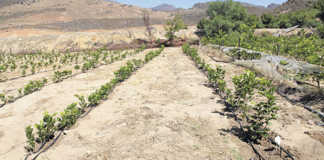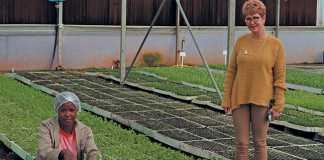
Photo: Courtesy of ARC
Although soya beans are grown worldwide, individual cultivars have a limited adaptation to specific geographical areas. Therefore, the soya bean cultivar best adapted to a specific locality will have the best yield and quality in the long term. We will look at the Agricultural Research Council’s soya bean cultivar recommendations.
READ: Barriers to entry in agro processing
Soya bean cultivar choices
Soya bean cultivar recommendations should be considered are important when choosing a soya bean cultivar, this starts with considering the length of the growing season. Unlike other crops, soya beans are sensitive to day length. A specific cultivar may ripen later, depending on how far south in Southern Africa it is planted, as this will determine the length of the growing season. The planting date also has a great influence on the length of the growing season, and soya beans planted at a later date could flower much earlier.
Temperature, too, plays a role. Soya beans grow much more slowly on the Highveld than in the warmer Lowveld
(see Table 1). Experienced producers can use soya beans’ photoperiod sensitivity and genetic variation with great success for a large part of the growing season.

This can, for example, be used for soya bean hay production (a long growing season cultivar), to schedule harvesting (plant cultivars with different ripening dates), or for drought avoidance or emergency planting (plant relatively short growing season cultivars).
Choosing the wrong cultivar presents a risk for inexperienced soya bean producers and could result in the cultivar not ripening at the correct time. For example, a ‘too-long grower’ could be ready for harvesting during rainy periods or when the temperature is too high. And a ‘too-short grower’s’ quality may be compromised if it cannot be harvested because of low pod height.
Growing season
Thirty one soya bean cultivars were included in the 2013/2014 trials, although only 19 localities are required for acceptable statistical analysis. These trials were conducted in warm, moderate, and cool production areas (see Table 2). Cultivars with a longer growing season will generally perform better in warmer growing areas, and cultivars with a medium growing season do better in moderate growing areas, while cultivars with a shorter growing season perform well in cooler production areas.
There are, however, exceptions and it is recommended that producers use yield performance and cultivar adaptation in combination with length of growing season. Planting date influences the adaptation of soya bean cultivars and therefore also cultivar choice. An earlier or later planting date will thus affect the choice of cultivar. The optimum planting time is in November, but in warmer areas soya beans can be planted until the first week of January.
Narrow rows, higher plant populations and shorter growing season cultivars are recommended for later planting dates. An October planting date is recommended for higher- altitude areas where soil and air temperatures reach acceptable levels early in the growing season.
Another consideration in cultivar selection is pod and plant height, as these affect harvesting. There is a correlation between pod and plant height and the length of the growing season. Under similar growing conditions, cultivars with a shorter growing season tend to have lower plant and pod heights compared with longer growing season cultivars.
Both characteristics are also influenced by production practices. Narrower inter- and-intra-row spacing will significantly increase pod height.
Increased plant growth
Standability is determined by the number of overcast days during the growing season. Plant height tends to increase during overcast weather and could result in a higher lodging percentage. Growth habit distinguishes between determinate and indeterminate genotypes.
Soya bean cultivars with a determinate growth habit should be planted under irrigation, while indeterminate cultivars (that do not stop growing vertically during flowering) do better in dryland conditions. Row width should also be taken into account in cultivar selection. Cultivars with more side branches and leaves are better adapted to wider rows, while cultivars with fewer side branches and leaves are better for narrower rows.
Seed-shattering resistance
Seed shattering resistance should also be considered. The National Soybean Cultivar Trials indicated that cultivars with a relatively short growing period tend to shatter more than cultivars with a longer growing period.
Herbicide sensitivity
In some cases, sensitivity to herbicides can also influence cultivar choice. No soya bean cultivars are resistant to atrazine-type herbicides and the full waiting period has to be enforced before planting. Also check the herbicide label to see whether it is suitable for the specific cultivar.
Environmental influence
Seed size, hilum colour, protein qualities and GMO status are important characteristics. Seed size is genetically regulated, but is greatly influenced by environmental conditions. Favourable conditions during the seed filling period will have a positive influence on seed size. Seed protein content, which is also genetically regulated, can be adversely affected by rainfall, temperature and stress. Ineffective crop management, poor or no nodulating, acidic soil and low soil fertility also play a role in soya bean quality.
Protein content calculation
A protein content lower than 36% is unsatisfactory, while protein content above 40%, on a moisture- free basis, is excellent. Seed yield indicates the genetic adaptation and suitability of a cultivar for a specific area. It is recommended that yield results be used in conjunction with yield- reliable values for a more accurate cultivar choice.
Yield-reliability table
Table 2 indicates whether the area to be planted is a warm, moderate or cool locality. The yield-reliability table can be used to select cultivars’ yield potential for a specific farm. Yield-reliability values provide valuable information for cultivar planning. These values are found on the lower reliability band of the regression graph, at a level of 90% probability.
.jpg)
The yield-reliability
value of a particular cultivar at a given potential is the minimum yield obtainable in nine out of 10 seasons. When calculating yield-reliability values, take the yield tendency, average yield and stability into account.
The following information is outlined in the yield-reliability tables:
- Yield-reliability values at different yield potential levels.
- The average yield of the cultivar for the set of trials used.
- Yield-stability is indicated by D²- values. A cultivar with D²-values approaching zero can be expected to be more stable and predictable in terms of yield. The greater the D²-values, the more the yield will vary between seasons.
Choosing a soya bean cultivar
Follow these procedures to choose a soya bean cultivar: Determine for what yield potential recommendations must be made.
- Consult the yield- reliability table for information on the desired yield potential.
- Select cultivars with the required yield potential and the highest yield-reliability values. The cultivars with the highest values should have the best chance of a stable, successful yield.
Phone Annelie de Beer or Mary James at the ARC Grain Crops Institute on 018 299 6100.
This article was originally published in the 28 November 2014 issue of Farmer’s Weekly.













